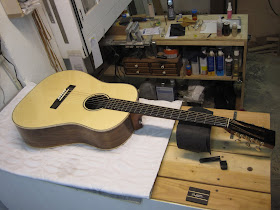Soundports have become popular for the way they enhance what
the player actually hears, sort of like a stage monitor for an acoustic guitar.
While on the surface it seems simple enough, just drill a hole in the side and
that’s that……but as with most things involving guitars it is not really that
simple. First the size of the port must be determined. This will also involve
the size of the main soundhole. On a new build this is not an issue as one can
adjust the size of the soundholes before they are cut but on an already
existing guitar sizing the port is critical to avoid spoiling tone. In this
case I was lucky that the main soundhole was a bit small for the body size.
The side of the upper bout where the port will be placed
will need some reinforcement to keep it from warping or splitting as the guitar
goes through its natural aging process. The body of the guitar is Walnut so
that will be the main part of my reinforcement. I thin out a piece of walnut to
the same thickness as the side and bend it to match the shape of the body on a
hot pipe. The patch is then trimmed to size. I love to use this old saw that
was my Great Grandfather’s for these types of tasks.
The side that will glue against the inside of the guitar is
laminated with a .025” thick mahogany veneer oriented cross grain. The mahogany
will add some stability and will serve to create a balanced veneer core panel
like a piece of furniture grade plywood. Here we see both sides of the panel
and how it fits the shape of the guitar. Notice it is not bent to the same
shape as the outside of the guitar but rather the inside where it will fit
against. The fit must be really good. Any voids in the glue up will ruin the
structural integrity of the reinforcement.
There is a small side brace in the guitar that is in the
way. It had to be removed very carefully to avoid tearing up the walnut side
and creating a void when I glue in the panel.
The inside of the guitar is prepped for the installation of
the panel by sanding the area with 220 and then a thorough cleaning. The panel
is glued in and held tightly in place by some repair magnets at the corners and
then firmly clamped with some wooden “go-bars”. This clamp arrangement is run
through a few times dry until I am satisfied that the panel is tight, in the
right position and can be accomplished in a reasonable time before the glue
starts to set.
Once this is completed I am ready to cut the new port. The side
is masked off and the port is laid out. The hole is cut using my dremel with a
router base and a spiral cut mill.
A bit of sanding and some finish and it is all finished.
Anyone would be hard pressed to tell that this was an addition to this guitar.










Well done!
ReplyDeleteWhen I added a sound port to a guitar, I didn't use wood to reinforce the area. Instead, I soaked a piece of thick linen cloth with LMI glue and pasted it onto the inside of the upper bout where the port was to go. When it was dry, I cut the port out. Two years later, everything seems to be holding together.
Many manufacturers have used cloth to reinforce F-holes in archtops. I will often reinforce cracked linings inside guitars with cloth when repairing hem.
ReplyDeleteThanks for this tutorial. I am trying to research on how to use a previously cut opening for a pre-amp on an acoustic. The pre-amp, now removed, has left a large, oblong opening in the upper bout area. There must be a way that I can use the existing cut out to install a port which will look much better. I was contemplating covering the cut out opening with black pick guard plastic and then cutting a new port in that. The guitar in question is NOT valuable to anyone but me. Before I got it, it had been mistreated and neglected for many years (cracks, holes, etc). Any thoughts would be appreciated. Jack
ReplyDelete